|
A
Philatelic Introduction to B.A.E. III: The Postal History
United
States Antarctic Service Expedition 1939-41
by
Joseph
Lynch, Jr., ASPP
Murray Fishler, ASPP
Gary Pierson,ASPP
PART
I: USMS (USS) NORTH STAR and the SNOW CRUISER
The
First Trip
The USS NORTH
STAR departed Boston, MA on November 15, 1939 while the USS
BEAR left Boston on November 22, 1939. Both ships made one United
States port-of-call enroute: The USS NORTH STAR stopped
at Philadelphia (leaving November 21), while the USS BEAR called
at Norfolk, VA on November 25 to take aboard one of the twin-engined Barkley-Grow
airplanes to be used on the expedition (departing November 26).
Philatelically speaking,
only the USS BEAR had an official post office and all mail
sent from either of the two bases or USS NORTH STAR was
canceled aboard the USS BEAR. However, much of her mail
can be found with one of two circular type markings:
|
|
|
|
|
USS
North Star Cachet TYPE I
|
USS
North Star Cachet Type II (LA)
|
USS North Star Cachet Type II (Palmer)
|
The illustration below
shows a cover posted with a double-circle cachet dated MAR 2, 1940. Various
dates can be found in these double-circle markings, but all those seen
by the authors indicate the year 1940 . . .
|
|
Our
example was canceled in Antarctica. January 17, 1940 found the
U.S.S. Bear and the U.S.M.S. North Star at Little America III unloading
supplies to establish West Base. On March 2, the U.S.M.S. North Star
was back in Antarctic waters and looking to meet up with the U.S.S.
Bear. The North Star was approaching Charcot Island from due north,
while both ships were searching for a sight to establish East Base.
Finn Ronne, who mailed this letter, was to lead his own expedition
to the Antarctic in 1947. He was to use East Base as his own base
and changed the name to OLEONA BASE. |
. . .
while all those with the single-circle cachet appear to have been used
only in 1941 . . .
|
|
The U.S.S. (U.S.M.S.)
North Star sailed from Seattle, Washington, December 11, 1940. She
arrived at the Bay of Whales, January 24, 1941 to help evacuate
West Base (Little America III), the second season. The U.S.S. Bear
departed Philadelphia, Pennsylvania, October 13, 1940. After several
stops, the last at Dunedin, New Zealand, she arrived at Little America
III on January 10, 1941 and began loading instruments, records and
other material. Most of the equipment, including the Snow Cruiser,
were left behind in the hope of reoccupying the base again in the
future. The U.S.S. North Star was a 1434-ton wooden ice ship with
diesel power, built for the United States Department of the Interior
in 1932. It was under the command of Captain Isak Lystad with its
regular crew.
This cover was
canceled on the U.S.S. Bear on January 26, 1941, two days after
the U.S.S. North Star arrived. The cover is signed by Captain Isak
Lystad.
|
Philatelically,
the most significant port-of-call enroute to Antarctica was made by the
USS NORTH STAR at Pitcairn Island on December 13-14, 1939.
The resultant covers, officially sanctioned by Byrd (who personally approved
the commemorative cachet), are among the most prized philatelic gems in
polar philately. The intricate pictorial cachet was designed by Richard
B. Black (impending leader of East Base), Dr. Alfred B. Geyer (one of
the medical doctors) and expedition official recorder Roger Hawthorne.
The official expedition record states that the cachet's stencil was "destroyed"
after printing of the 794th envelope.
The Pitcairn
post office was quickly sold out of New Zealand stamps, but through special
arrangements by Pitcairn's first postmaster, Richard Edgar Christian,
payment was accepted in US currency ($27.25 total) for servicing of the
covers, treating them as stampless, pre-paid letters. Postmaster Christian
initialed the cancellation "R.E.C." to certify their pre-payment.
Deposited mail later was picked up by a passing ship, entering the US
postal system at San Francisco, California, on or about February 6, 1940.
When questioned
in 1982-83, several authoritative members of the American Society of Polar
Philatelists and Pitcairn Islands Study Group concurred that only about
15-20 covers are known, with twice this number probably being extant.
There are instances of these having been bought at auction for over $1500.
Two types
of mail from this stop exist -- mail left at Pitcairn for a stateside
destination . . .
|
|
This
cover was mailed to Dr. and Mrs. Mann at the National Zoological Park
in Washington, D.C., sent by Malcolm Davis, a bird curator at the
park. Davis participated on Byrd III as a biologist aboard the USS
NORTH STAR and was the ornithologist during Operation
Windmill, 1947-48. |
. . . and mail canceled
at Pitcairn and taken along for the journey south . . .
|
|
Dr. Thomas C.
Poulter was the leader of the tractor party, to Bolling Advance
Base, to rescue Admiral Richard E. Byrd, during the Second Byrd
Antarctic Expedition. He later became the scientific director of
the research foundation of the team that designed the Snow Cruiser.
It was built at the Pullman Company, at a cost of $150,000, which
was paid for by private contributions. It was found out in Antarctica
that the Snow Cruiser could not climb out of it's own tracks in
the snow, so it was parked at Little America, a failure!!
This cover is
addressed to the governor - a magistrate of the island. He was one
of only two white men living on the island. He was a French viscount,
that was accused of murdering three men in Paris. He was then sent
to spend his life on Rapa Island.
|
Mail
posted at Pitcairn and carried onward usually has at least one additional
cancellation besides the Pitcairn postmark. Most all of this mail is canceled
with a Pitcairn 14 December 1939 date, however three examples have been
found with a December 13 cancellation (Vogel, Ice Cap News, Jan-Mar 1997).
One of the three examples has both a Wellington, New Zealand (27 December
1939) and USS BEAR (14 January 1940) cancellation on a cacheted
envelope signed by Miss Alta Christian, descendant of mutineer Fletcher
Christian. As can be seen in the illustrations above, two distinct Pitcairn
cancellation types were used on Byrd III covers.
|
|
Cristobal, CANAL
ZONE was the first stop of the U.S.M.S. North Star outside the United
States. This attractive cover received the Cristobal cancel on November
29, 1939. The Cristobal cancel is hard to find as the North Star did
not land, but dropped anchor considerably off shore. Four men, including
Ted Petras, went ashore in a launch. This cover then was carried to
Pitcairn where it received the rare December 13 cancellation (before
they ran out of stamps). It was then canceled at Rapa Island (before
they ran out of stamps) on December 17. On December 27, 1939, at Wellington,
New Zealand, he mailed the cover to himself at Dunedin and it was
held there until the ship arrived on December 29, 1939. (Back-stamped
"Delivery" before arrival). The final cancellation came
on February 1, 1940....the departure date of the U.S.S. Bear from
Little America III. |
On December 17, 1939,
three days after it left Pitcairn Island, the U.S.A.S.E.'s command ship
stopped at Rapa Island (Ile Rapa) in the South Pacific. There are at least
three different types of covers extant from the stop. The first has French
Oceanic postage stamps canceled at Ahurei, Ile Rapa . . .
|
|
USASE
... December 17, 1939 ... at the south sea island AHUREI, ILE RAPA
This cover was
mailed by Finn Ronne, second in command at East Base. The cover
was carried to New Zealand and placed into the mail system at Wellington.
|
. . . the second is
sans postage and canceled similarly . . .
|
|
This
piece was handed back to expedition member Arnold Court, the meteorologist
for West Base. Rapa Island ran out of stamps shortly after the arrival
of the expedition ship. |
. . . the
third type was mailed and canceled there without postage and forwarded
on to Papeete, Tahiti, where a French Oceanic stamp was added; the stamp
was canceled there while in transit . . .
|
|
The U.S.M.S.
North Star stops at RAPA ISLAND.....no stamps are left! Stamps were
added at Papeete, TAHITI and canceled again there. This cover was
from crewman Boston B. Hunt. |
Mail ships evidently don't stop
too often at Rapa Island. A variety of "combination" covers
exist with additional cancels from other stops of this expedition, as
illustrated by this cover sent by the ship's Captain I. Lystad . . .
|
|
Pitcairn Island
cancel (no stamps available), initialed "REC" by Postmaster
Richard Edgar Christian to show postage was paid. (December
14, 1939). AHUREI, ILE RAPA canceled with stamps (December
17, 1939). Wellington, New Zealand (December
30, 1939). U.S.S. Bear at Little America III with 5¢
postage overseas rate (January 17, 1940).
U.S.S. North Star "Double Circle" cachet .... departure
from East Base (March 20, 1940).

Backstamped
at Balboa, Canal Zone, where it was deposited into the U.S. mail
system (April 12, 1940).
|
Some covers also have
a straight line cachet that has been seen on the different types of covers
(see above), reading "AHUREI - ILE RAPA". The vessel made a
stop at Wellington, New Zealand for three days in late December, 1939.
Pieces with only a Wellington cancellation are very rare.
The fleet entered
the Bay of Whales in January, 1940. The first to arrive was the USS
NORTH STAR on January 12, followed by the USS BEAR
two days later. Little America III was established under Station Leader
Dr. Paul A. Siple, and several exploratory
flights were made. Master Technical Sergeant Theodore A. Petras, U.S.M.C.
sent a letter with the USS NORTH STAR when she left Little
America on January 24, 1940, on her way to Valparaiso, Chile to pick up
supplies for East Base . . .
|
|
United States
Antarctic Service Expedition "U.S.M.S. North Star" at
Valparaiso, Chile. Canceled "N.Y. & VALP. S.S. SANTA CLARA
U.S. SEA POST" . . . this is the first mail dispatch from West
Base.
Master Technical
Theodore A. Petras, U.S.M.C., sent this cover with the U.S.M.S.
North Star when she left Little America III (West Base), on January
24, 1940. She sailed for Valparaiso, Chile, to pick up supplies
that were waiting to be used to establish East Base. She arrived
February 15, 1940. The S.S. Santa Clara was there on her usual run
from New York. This cover was mailed the next day through her U.S.
Sea Post.
|
The vessel
arrived in Valparaiso on February 15, 1940. The SS SANTA CLARA
was there on her regular run and the cover displayed above was mailed
the next day. It was canceled N.Y. & VALP. S.S. SANTA CLARA / U.S.
SEA POST / FEB 16, 1940. This was the first mail from Little America on
the United States Antarctic Service Expedition. The SS SANTA CLARA
departed Valparaiso, Chile on February 16 and arrived at New York
City on Tuesday, March 5, 1940. Mst. Tech. Sgt. Ted Petras was the pilot
for the Beechcraft airplane that was to be carried on the roof of the
Snow Cruiser on her trip to the South Pole. Ted Petras remained at West
Base (Little America).
Mst.
Tech. Sgt. Ted Petras and the Snow Cruiser
The second
example from this stop represents mail sent from West Base (Little America),
canceled on the USS BEAR on January 14, 1940. J. Gambole,
a crewman on the USS NORTH STAR, retrieved his mail and
carried it with him to Valparaiso, Chile. He mailed it at a post office
in Valparaiso on February 20, 1940. J. Gambole, in his return address,
correctly uses "U.S.M.S. (UNITED STATES MOTOR SHIP) NORTH
STAR" as she was not yet a U.S. Navy ship since she belonged
to the U.S. Department of the Interior during this expedition. Incidentally,
she officially became a U.S. Navy ship during the Second World War, when
on January 13, 1944, she was assigned to the First Naval District . .
. she was decommissioned June 15 and was returned to the Department of
the Interior.
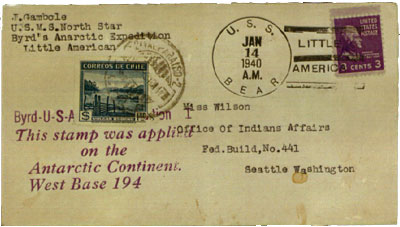
The top line
of the West Base Cachet reads "Byrd-U.S. Antarctic Expedition
I." In the year (194 ) on this cachet, the last number was
to be added by hand as they intended to use this cachet for more
than one year.
|
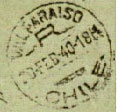
Backstamped
February 20, 1940
This
cover was originally mailed on the U.S.S. BEAR at West Base (Little
America III) on January 14, 1940, by J. Gambole. When he realized
it could be delivered faster, he took back this mail and carried
it with him on the U.S.M.S. NORTH STAR to Valparaiso, Chile. He
mailed it there on February 20, 1940, five days after they had
arrived. J. Gambole, a crewman on the NORTH STAR, correctly used
the ship designation in his return address which is one of the
few times that the ship was correctly referred to as the U.S.M.S.
(United States Motor Ship) NORTH STAR.
|
The primary
purpose for the visit of the NORTH STAR to Valparaiso
was to retrieve supplies and equipment for East Base. Here, too, waiting
to join the ship were Lieutenants 1st Class Ezequiel Rodriguez and Federico
Bonert of the Chilean Navy and Lieutenant 1st Class Julio Poch and Lieutenant
(jg) Emilio L. Diaz of the Argentine Navy, who at the invitation of the
United States Government had been appointed to join the ship as observers
on the voyage. The
USS NORTH STAR sailed for Antarctica on February 23, 1940.
1st Class Lt. Julio R. Poch, of the Argentine
navy . . . "our correspondent in Byrd's Expedition to the
Antarctic continent." *
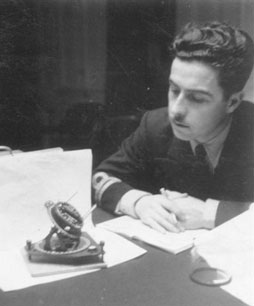 1st Class
Lieutenant Julio R. Poch
1st Class
Lieutenant Julio R. Poch
Argentine Navy |
(At
Little America) " . . . Admiral Byrd boarded the BEAR
and on January 20 initiated an exploration journey towards
the east, returning afterwards to the base. Once the base
was provisionally installed, he proceeded to the magnetic
pole and on February 8 headed east for Palmer Land.
Meanwhile,
having finished unloading at the new Little America, the
NORTH STAR set out for Valparaiso
on January 25. There Dr. Poulter, director of the Chicago
Armour Research Foundation, veteran of the Antarctic expedition,
disembarked and returned to the United States, and we went
on board: two officers of the Chilean Navy and two from
Argentina who joined the American personnel in this new
stage. On February 23 the NORTH STAR
left Valparaiso heading south.
On March
2 both ships were in the Bellingshausen Sea. The BEAR
had completed an interesting exploration campaign in its
voyage from Little America, navigating south of every point
ever reached before by any ship in that area.
The
northern coast of Charcot Island and Alexander I Land was
explored. On March 5 both ships met at the mooring area
of Horseshoe Island. In the following days the vessels sailed
along the coast of Marguerite Bay and from the hydroplane
on the BEAR all its extension
was explored. It was decided to install the new base on
an isle close to the coast and connected to it by an ice
bridge on the northern edge of Neny Fiord.
In this
time of year the temperature is not rigorous, reading only
12° C below zero; winds are strong but the location
offers good shelter for anchorage. Ice formations are rare
and icebergs not very numerous. For all these reasons the
unloading of over 500 tons of supplies becomes feasible,
if not easy. |
The
unloading operations have been paralyzed for two days now ...
today is March 19 ... because of the hurricane wind that blows
from the east. Last night the two anchors of the NORTH
STAR were dragging in spite of the good shelter
offered by this corner of the Neny Fiord.
Dawn
breaks. The sky is almost clear. It is cold. The wind keeps blowing
but with no strength. At 9, the unloading resumes and the five
men that have been stranded for two days on the isle of the future
base return on board.
The
idea of spending the night on Antarctic land occurs to me and
I talk about it to my good friend, veteran Finn Ronne. Ashore,
in one of the trips of the boat, I discover that our tidal measurement
instrument has become an artistic but useless ice monument. In
the afternoon Lieutenant Diaz and I clear it.
In
the camp there are fallen tents covered with snow. They are removed
with great effort.
I
visit the dog villa where "Silver" welcomes me showing
his joy with the rapid movement of his legs. His eighty companions
produce a commotion evidently vying for my attention.
I
am then told that the Commander, Mr. Black, has ordered me to
stay at the camp for the night in a tent shared with Donald Hilton,
an excellent boy who works as hydrographer and sledge driver.
So,
I go on board for dinner and return to the beach with the motorboat
of the last cargo.
At
sunset everybody leaves on the boats and I take alone the path
of the tents. The view of the bay is beautiful and quiet, quite
different for sure from the idea I had of the coasts of Palmer
or Graham Land, misled by exaggerated descriptions and photographs
of frozen landscapes. It is true that I step on ice and that there
are some icebergs close to our ship, but the mountains that surround
us show their dark slopes and they extend themselves in rocky
"restinga" vegetation on the clear water of the bay.
The
tent is small, of the kind meant for sledge journeys, of thin
windproof material and canvas floor. My companion has lit a gas
lamp and a good heater. My friend Harry comes to visit. He lives
in the plane with no light or heat. He is youthful and pleasant.
He is writing a letter that I will take to his sister who lives
in Buenos Aires and whom I met in Bermuda (proof of the smallness
of the earth). We talk with Hilton about our astronomic positions
and we comment cheerfully in spite of my doubtful English.
I
go out to accompany Harry. The dogs have become quiet. The night
is clear with little wind; the temperature is 5° C below zero.
The plane, 100 miles away, resembles a stain in the milky continuity
of the ice.
I
go again through the funnel of fabric that acts as the door. The
water in the jar on the floor of the tent is frozen and we can
eat like ice cream a soup left over from this afternoon. We prepare
our sleeping bags and I make myself comfortable in one. By indication
of my companion I put on the thick hood lined with wool that seems
unnecessary now but will become essential later. The fires burn
out. A moment later a choir of lamentations is heard from "dog
town." They must be saluting the moon that appeared through
the clouds. Then, an Antarctic silence that every "porteño"
(inhabitant of the city of Buenos Aires) would envy and then ...
nothing else.
Our
eighty neighbors bark furiously. Hilton has already lit the "primus."
It is morning. My deep sleep has not allowed me to appreciate
the Antarctic night in more detail.
As
we go to the embarking point, the boat with the first load is
already approaching. Soon the powerful tractor snores, skillfully
driven by Morency. The tasks for the installation of East Base
resume.
Displayed
below is a cover from Julio Poch, addressed to his mother, while
aboard the USS NORTH STAR. The cover received the appropriate
TYPE I NORTH STAR cachet. Admiral Byrd subsequently
invited Poch to join him on the BEAR for
the return trip to Magallanes (Punta Arenas). The lieutenant retrieved
his letter and upon boarding the BEAR, his letter received
a strike of the USS BEAR's Little America canceller.
The cover also received a strike of the East Base penguin cachet.
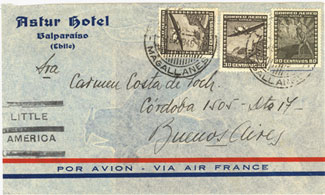 A gorgeous
example of this rare leg of the expedition.
A gorgeous
example of this rare leg of the expedition. |
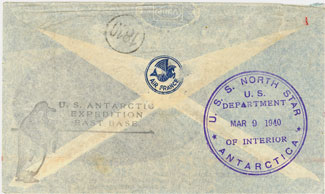 Reverse
with the USS NORTH STAR Type I
and EAST BASE penguin cachets
Reverse
with the USS NORTH STAR Type I
and EAST BASE penguin cachets |
On
March 21 (a record date for ships navigating in the area) both
ships left in succession. The NORTH STAR
went directly to Valparaiso to proceed later to Panama and Seattle,
her registration port. The BEAR, taking
the Admiral and the four Latin American officers at his invitation,
made a detour first to the south to the coast of Alexander I,
and then to the west looking for a bank called Pactolus Bank.
Then by invitation of the Chilean Government she proceeded to
Punta Arenas and Puerto Montt, then to Valparaiso and later to
Boston via Panama, experiencing during the journey two of the
most violent storms that the southern region of the continent
usually offers."
Sunday,
March 31, 1940 at the race tracks in Magallanes (Punta Arenas)
L
to R: Adm. Huber (Chief of the navy station in Magallanes),
Adm. Byrd,
the mayor of Magallanes, Lt. Julio Poch
|
April
4, 1940, in Cabo de Hornos
L
to R: Lt. Bonert from Chile, Adm. Byrd, Lt. Julio Poch
|
___________
* Translated from the Thursday, April 4th and April 25th, 1940,
editions of the Buenos Aires newspaper, "La Prensa"
. . . and from a radio transmission
received by his mother on Monday, March 18, 1940 . . .
"On
Monday March 18 at 9:30 p.m. begins the transmission on RADIO
SPLENDID. Admiral Byrd speaks first, from the BEAR,
in English. His kind and praising words for Chileans and Argentines
are translated. He tells an anecdote: "An explorer was asked
after a long time in isolation away from civilization what he
missed the most and he answered, "Temptation."
Then
from the NORTH STAR, Julio and Lieutenant
Diaz spoke. At first there were loud discharges and we could barely
hear but the transmission got clearer and clearer. Diaz described
the simple and pleasant life on board: one course and dessert
to eat, and a choice of tea, coffee or chocolate to prepare themselves
at any time of day. It is not very cold: 12° C below zero
minimum, 2° C over zero maximum. Then Julio's voice was heard,
clear and so animated and cheerful that he left us the most agreeable
impression. It seemed to us that we could see him in his best
enthusiastic and optimistic days.
He
talked about the ice, about the first icebergs, the encounter
with the whales (the ship collided with one) and the blizzards.
Surrounded by ice the ship goes forward slowly breaking it. They
seize the opportunity to practice ski with the Chileans. He names
the islands they find; they can see many earth mountains, not
very high, and incredibly beautiful bays that remind him of Funchal.
He dedicates this memory to Leon, Franzini and Rodriguez. He says
that Diaz collects flora and fauna samples, directed and aided
by the specialists. Julio helps them with the digging but he mainly
acts as their pet. He speaks of the pleasant life on board, of
the excellent American and Chilean companions, of the admiration
that Byrd arises in them when they meet him and he invites them
to eat in his company.
Then
Mr. Black speaks in correct Spanish, very charming. Then they
say goodbye. Julio says, "I send my love to those at home,
to Uncle Julio, to the people I love in Montevideo. I salute the
navy officers, my companions at the navy school and the cadets.
Greetings to my friends and love to "X". This was heard
with an admirable clarity and naturally we were all intrigued.
For how many "X's" was the greeting meant? That is the
real mystery.
When
the transmission was over I immediately called Transradio and
spoke with the operator that was still communicating with Julio.
I was able to tell him of our joy at having heard him so well
and to send him all our love.
The
operator holding the receiver to one ear listened to me and relayed
to Julio what I said while listening to him with the other ear.
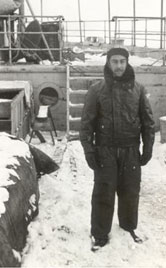
Lt. Poch aboard USS
NORTH STAR
____________
A special "thank you" to Patricia Poch (daughter of
Lt. Julio Poch) for your contribution of newspaper articles and
radio transmission log, as well as for the translation of these
documents. I am also grateful for the cover displayed above, along
with the photos from your personal estate.
The
Webmaster
|
Following
the USS NORTH STAR'S resupply run to Chile, both ships anchored
off the Palmer Peninsula and unloaded supplies for East Base from 11-21
March.
|
|
U.S.S. Bear
and U.S.S. North Star cancellation. The March 8, 1940 cachet of
the North Star is the date of the landing on Stonington Island to
establish East Base at Neny Fiord.
The "Standing
Bear" cachet, dated March 20, 1940, was the last day in Antarctica.
|
Unloading
the NORTH STAR at East Base
Following
completion, the USS BEAR sailed for Boston while the USS
NORTH STAR headed for Seattle, from whence she was scheduled to
make here regular summer cruise to Alaska for the Department of the Interior.
Admiral Byrd left with the fleet and did not return to Antarctica until
Operation Highjump in 1947.
|
|
After
leaving East Base on March 21, 1940, the U.S.M.S. North Star stopped
at Balboa, Canal Zone, on her way to her home port at Seattle, WA.
The Fourth Officer, William Schroeder, sent this letter to his parents
in Newton, MA. He mailed it the day they landed, April 12, 1940. |
Snow
Cruiser Covers
|
|
Where did they
store the 10,000 covers? Probably between the rear wheels.
Ted Petras was
the pilot and navigator for the Snow Cruiser and it's Beechcraft
stagger-wing (MODEL D17A) airplane. The photo of Dr. Russel G. Frazier,
M.D. and Ted Petras was taken in 1940 on the Ross Ice Shelf in Antarctica.
|
Since the
Snow Cruiser was carried to Antarctica on board the main deck of the USS
NORTH STAR, it was fitting that covers commemorating this large
vehicle be associated with the vessel in the manner shown below . . .
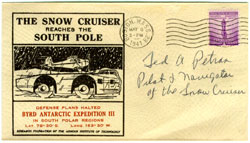
 
Anyone
who has ever tuned up the family vehicle or repaired the broken household
washing machine will appreciate the mechanical beauty of the Snow Cruiser
. . .
With it's
crew's quarters, mess hall, dark room, etc., it was a self-contained luxury
liner (by polar standards) designed to travel to the South Pole and return
under its own power. It saddens a do-it-yourselfer like myself that there
were insufficient facilities and materials at Little America III to change
the deficiencies built into the cruiser. Chains were applied to the tires
but it did not help her poor traction. A regearing ratio was required
but the limited resources at Little America prevented such major changes
to be made to her design. The very best this beautiful machine could do
was to travel the few miles from the sea-ice to the base and there she
was eventually buried in hopes that she could be used at a later date
and time. Unfortunately she sailed out to sea many years later (1964)
when the section of the Ross Ice Shelf in which she was buried broke off
along with the base. The moment, strangely enough, was captured on film
by Naval personnel during Operation Deepfreeze.
The cruiser's
airplane did yeoman service for the U.S.A.S.E. at West Base but never
got a chance to ride "piggyback" over the ice-shelf or polar
plateau.
Fidelity
Stamp Company, of Washington, D.C., issued several types of advertisements
for the cruiser covers it intended to sell. Postcards and printed envelopes
indicated to prospective buyers the departure date and cost per item.
The semi-finished product for sale, which was carried south by the USS
NORTH STAR, had space reserved for a later addition of wording
which proposed to give the time and date of a successful arrival at the
South Pole. Unfortunately, the 4-line cachet, as illustrated above, had
to be added instead. An additional "Registered" marking was
added to the reverse of the covers with individual numbers for each cover
returned to the States (see above). The latter, as well as the "DEFENSE
PLANS HALTED" cachet were, of course, untrue. No cover would ever
have reached the Pole on the Snow Cruiser under the circumstances and
none of the covers were ever sent by registered mail to this writers knowledge.
Upon departing
the Antarctic in 1941, West Base members retrieved many of the envelopes
which were on board the cruiser and these were returned to Fidelity for
the above-mentioned cachet. A very rare example exists from this date
which was canceled on the USS BEAR . . .
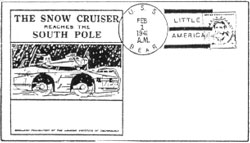
Thousands
of covers were canceled at Boston, MA by machine (see color example above)
on May 6, 1941, and others, which are more uncommon, were canceled by
hand on the same date . . .
|
|
UNITED
STATES ANTARCTIC SERVICE EXPEDITION
THE SNOW CRUISER COVERS RETURN TO BOSTON, MASSACHUSETTS
The covers were all returned on the USS North Star. A few random
covers had blocks of stamps, rather than singles, put on the covers.
The ones with blocks were hand canceled instead of machine canceled
and are quite rare.
|
A number
of envelopes were apparently left behind on the cruiser, buried under
the snow, to await the arrival of the next visitors to Little America.
In 1946-7 the Central Group of ships of OPERATION
HIGHJUMP moored to the ice in the Bay of Whales and built
Little America IV. During the time of their stay, visits were made to
Little America III and, of course, to the buried Snow Cruiser. Some of
the remaining envelopes were taken by the searchers and canceled aboard
ships of the Central Group. When Little America V was established during
the early Deepfreeze years further visits were made to the Snow Cruiser
and even more envelopes were retrieved. These can be found with a variety
of annotations, cancels and cachets. Deepfreeze 1957-8 apparently cleaned
out the cruiser of old envelopes because she did not go to her watery
grave until 1964 yet covers are not known to this writer after the 1957-8
season.
The crew
of the Snow Cruiser in 1940-1 did have access to some printed stationary
all their own (i.e. the Ted Petras and Pitcairn Island examples illustrated
earlier). Writing paper with a Snow Cruiser letterhead was also used by
Ted Petras, the Marine sergeant who piloted the Snow Cruiser's Beechcraft
airplane. Other examples surely exist.
Perhaps
this will clear up for the collector that puzzling question of why envelopes
which were originally designed for use with the United States Antarctic
Service Expedition 1939-41 appear on the scene with cancels dated during
Highjump and Deepfreeze. It would be difficult, I would think, to find
a more available source of covers which overlap three different Antarctic
expeditions.
CONTINUED
ON THE NEXT PAGE
|

